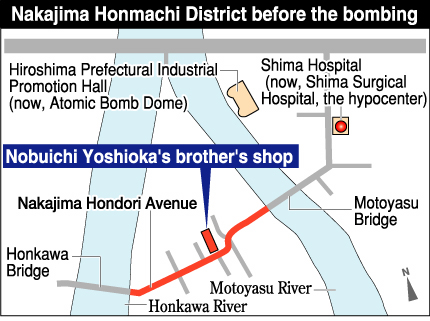Footage of Nakajima Honmachi, a district that disappeared in the bombing
Aug. 1, 2008
by Yoko Nitta and Hideshi Iwasaki, Staff Writers
Recently, it was learned that the late Nobuichi Yoshioka shot some film footage of the Nakajima Honmachi District (now, Nakajima-cho), an area that has since become part of Hiroshima Peace Memorial Park. Mr. Yoshioka also captured footage of downtown Hiroshima before and after the atomic bombing on 8 millimeter film. As a result of the blast, the busy, bustling district of Nakajima Honmachi was transformed into a place of prayer. This footage is thought to feature the first known moving images of Nakajima Honmachi as it existed before the bombing.
View the film.
Please visit the Peace Museum.
The Nakajima Honmachi District was located in the northern part of today’s Hiroshima Peace Memorial Park. The district, with Nakajima Hondori Avenue running between Motoyasu Bridge and Honkawa Bridge, can be identified for approximately 35 seconds in the film. This footage of the Nakajima Honmachi District, and the Kawaya-cho District, appears to have been shot between 1937 and 1940. Kawayo-cho is the area where Mr. Yoshioka lived and is now part of the Hondori District.
Because his older brother ran a fabric store on Nakajima Hondori Avenue, Mr. Yoshioka shot images of the shop and the street. Until the early 1940s, Nakajima Hondori Avenue was a more prosperous section of that thoroughfare than Hondori Avenue in Kawaya-cho. Lively shops stood side by side on Nakajima Hondori Avenue, fashionably adorned with street lights shaped like lily-of-the-valley flowers. (Hondori Avenue had these street lights, too, but the shape was slightly different.) Mr. Yoshioka’s footage also features a large number of shoppers strolling along the street in conjunction with the Ebisu Grand Festival held in Kawaya-cho.
The Nakajima Honmachi District was located within 500 meters of the hypocenter so it was turned into a burnt plain by the atomic blast. A survey conducted by the Chugoku Shimbun found that approximately 80 percent of its residents had died by the end of 1945. After the war, this district and the other districts in the vicinity that make up 12.2 hectare were redeveloped into Hiroshima Peace Memorial Park, in accordance with the Hiroshima Peace Memorial City Construction Law.
Kazuhiko Takano, Director of the Hiroshima Municipal Archives, commented, “I’ve never seen moving images of the Nakajima Honmachi District before. This is a very rare and valuable artifact. The images convey the atmosphere of the shopping arcade and the energy of the district.”
Before the bombing, Mr. Yoshioka had taken his film reels to a relative’s house on the island of Kurahashi, near the city of Kure, for safekeeping. Afterwards, his eldest son, Hiroo, 82, now a resident of Asakita Ward, Hiroshima, preserved the footage. The films reveal scenes of downtown Hiroshima, captured both before and after the bombing from a similar vantage point.
(Originally published on July 25, 2008)
Related articles
Footage of Hondori Avenue, before and after the atomic bombing, is found (July 24, 2008)
Recently, it was learned that the late Nobuichi Yoshioka shot some film footage of the Nakajima Honmachi District (now, Nakajima-cho), an area that has since become part of Hiroshima Peace Memorial Park. Mr. Yoshioka also captured footage of downtown Hiroshima before and after the atomic bombing on 8 millimeter film. As a result of the blast, the busy, bustling district of Nakajima Honmachi was transformed into a place of prayer. This footage is thought to feature the first known moving images of Nakajima Honmachi as it existed before the bombing.
The Nakajima Honmachi District was located in the northern part of today’s Hiroshima Peace Memorial Park. The district, with Nakajima Hondori Avenue running between Motoyasu Bridge and Honkawa Bridge, can be identified for approximately 35 seconds in the film. This footage of the Nakajima Honmachi District, and the Kawaya-cho District, appears to have been shot between 1937 and 1940. Kawayo-cho is the area where Mr. Yoshioka lived and is now part of the Hondori District.
Because his older brother ran a fabric store on Nakajima Hondori Avenue, Mr. Yoshioka shot images of the shop and the street. Until the early 1940s, Nakajima Hondori Avenue was a more prosperous section of that thoroughfare than Hondori Avenue in Kawaya-cho. Lively shops stood side by side on Nakajima Hondori Avenue, fashionably adorned with street lights shaped like lily-of-the-valley flowers. (Hondori Avenue had these street lights, too, but the shape was slightly different.) Mr. Yoshioka’s footage also features a large number of shoppers strolling along the street in conjunction with the Ebisu Grand Festival held in Kawaya-cho.
The Nakajima Honmachi District was located within 500 meters of the hypocenter so it was turned into a burnt plain by the atomic blast. A survey conducted by the Chugoku Shimbun found that approximately 80 percent of its residents had died by the end of 1945. After the war, this district and the other districts in the vicinity that make up 12.2 hectare were redeveloped into Hiroshima Peace Memorial Park, in accordance with the Hiroshima Peace Memorial City Construction Law.
Kazuhiko Takano, Director of the Hiroshima Municipal Archives, commented, “I’ve never seen moving images of the Nakajima Honmachi District before. This is a very rare and valuable artifact. The images convey the atmosphere of the shopping arcade and the energy of the district.”
Before the bombing, Mr. Yoshioka had taken his film reels to a relative’s house on the island of Kurahashi, near the city of Kure, for safekeeping. Afterwards, his eldest son, Hiroo, 82, now a resident of Asakita Ward, Hiroshima, preserved the footage. The films reveal scenes of downtown Hiroshima, captured both before and after the bombing from a similar vantage point.
(Originally published on July 25, 2008)
Related articles
Footage of Hondori Avenue, before and after the atomic bombing, is found (July 24, 2008)








